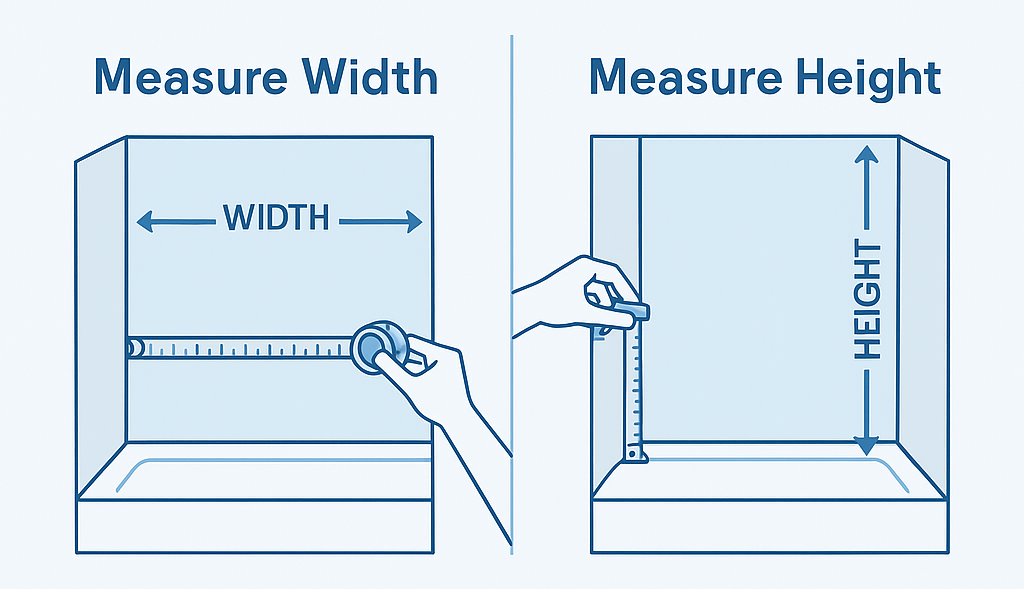
What Size Shower Door Do I Need? A Quick Measurement Guide
Share
Choosing the right shower door size isn’t always as straightforward as it sounds. Whether you're remodeling your bathroom or replacing an old door, getting the correct measurements is essential for a clean fit and a leak-free experience.
In this quick guide, we’ll walk you through how to measure your shower space accurately and what to consider when selecting your shower door size.
Why Shower Door Size Matters
A properly sized shower door doesn’t just improve the look of your bathroom — it also ensures:
- Smooth installation (especially for DIY)
- No water leakage
- Safe daily use
- Maximized space efficiency
Picking the wrong size can lead to gaps, drafts, or doors that simply won’t close correctly. Let’s avoid that.
Step 1: Know Your Shower Type
Before you take out the measuring tape, you need to identify the type of shower enclosure you have:
- Alcove (3-wall): Most common in tubs or walk-in showers. Needs one sliding or pivot door.
- Corner (Neo-angle): Enclosures that fit into a corner with angled glass panels.
- Standalone Walk-in: May need a single glass panel or a swinging door.
- Bathtub/Shower combo: Requires a bypass sliding door or a pivot panel mounted on the tub.
Each setup may have different measurement requirements.
Step 2: Measure the Width
Use a steel tape measure to check the distance between the two walls where the door will be installed.
- Take three measurements — top, middle, and bottom.
- Record the smallest of the three. Walls are rarely perfectly square, and the narrowest width is your true reference point.
📏 Standard width ranges:
- Sliding shower doors: 56"–60"
- Pivot doors: 28"–34"
- Tub doors: 56"–60"
If your opening is not standard, look for doors with adjustable rails (like iBath models) that allow up to 4" of trimming.
Step 3: Measure the Height
This is measured from the top of the shower curb (or tub edge) to the top where you want your shower door to end.
Most common heights:
- Shower doors: 72"–76"
- Tub doors: 56"–60"
Pro tip: If you’re tall or have high ceilings, go for taller panels for better splash control and a more open feel.
Step 4: Consider Glass Thickness
You’ll find most residential doors in:
- 1/4" (6mm) — durable and lighter, ideal for sliding or pivot doors
- 3/8" (10mm) — heavier, often frameless, offers a luxury feel
- 1/2" (12mm) — premium look, requires sturdy hardware
Heavier glass may look sleek, but it also needs stronger walls and anchors. If you're installing it yourself, 1/4" tempered glass is usually safer and easier to manage.
Step 5: Left or Right Opening?
Many pivot or hinged doors are reversible, but some are not. Make sure you know:
- Which direction the door should open
- If there are any obstructions (toilets, vanities, towel bars)
Check product listings for “reversible design” or “left/right-handed installation.”
Step 6: Framed, Frameless, or Semi-Frameless?
Framing doesn’t affect size as much as it does style and installation:
- Frameless: Sleek and minimal, but requires more precise measurements.
- Framed: Slightly forgiving with sizing and installation.
- Semi-frameless: A good middle ground. Stylish and practical.
For example, iBath’s semi-frameless doors offer adjustable rails and easy-install features that work well even if your walls aren’t perfectly square.
Common Sizing Mistakes to Avoid
- Measuring before tile installation: Always measure after tiles are set. This gives the final opening size.
- Ignoring wall unevenness: Always measure at three points.
- Assuming “one size fits all”: Even a ½-inch mistake can lead to leaks.
- Not checking threshold depth: Most doors need a 2-3/8" minimum curb depth for proper installation.
Final Tip: Check the Product Specs Carefully
Each shower door model has its own recommended opening range and installation notes. Always read the specs — and if you’re unsure, reach out to the manufacturer for clarification.
Wrap-Up
Knowing your shower space dimensions is key to choosing the right door. With just a tape measure and a few minutes of your time, you can avoid costly returns or ill-fitting installations.
Looking for an adjustable, easy-to-install shower door? Check out iBath’s range of sliding, pivot, and semi-frameless doors — designed with real bathrooms in mind.
